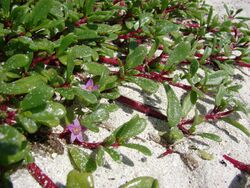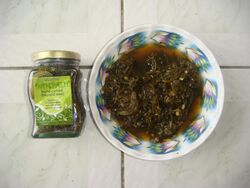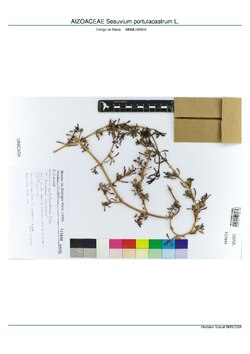Biology:Sesuvium portulacastrum
| Sesuvium portulacastrum | |
|---|---|

| |
| Scientific classification | |
| Script error: No such module "Taxobox ranks".: | Plantae |
| Script error: No such module "Taxobox ranks".: | Tracheophytes |
| Script error: No such module "Taxobox ranks".: | Angiosperms |
| Script error: No such module "Taxobox ranks".: | Eudicots |
| Script error: No such module "Taxobox ranks".: | Caryophyllales |
| Script error: No such module "Taxobox ranks".: | Aizoaceae |
| Script error: No such module "Taxobox ranks".: | Sesuvium |
| Script error: No such module "Taxobox ranks".: | <div style="display:inline" class="script error: no such module "taxobox ranks".">S. portulacastrum |
| Binomial name | |
| Sesuvium portulacastrum | |
| Synonyms[2] | |
|
Synonymy
| |
Sesuvium portulacastrum is a sprawling perennial herb in the family Aizoaceae that grows in coastal and mangrove areas throughout much of the world.[3] It grows in sandy clay, coastal limestone and sandstone, tidal flats and salt marshes,[4] throughout much of the world. It is native to Africa, Asia, Australia , Hawai`i, North America and South America, and has naturalised in many places where it is not indigenous.[5]
It is commonly known as shoreline purslane[6] or (ambiguously) "sea purslane," in English, dampalit in Tagalog and 海马齿 hǎimǎchǐ in Chinese.
Description
Sesuvium portulacastrum is vine up to 30 centimetres (12 in) high, with thick, smooth stems up to 1 metre (3.3 ft) long. It has smooth, fleshy, glossy green leaves that are linear or lanceolate, from 1–7 centimetres (0.39–2.76 in) long and 2–1.5 centimetres (0.79–0.59 in) wide.[7][4]
Its flowers come from at the leaf axils, they are tiny, 0.5 centimetres (0.20 in) in diameter and pink or purple in colour.[7][4] They close at night time or when the sky is cloudy, they are pollinated by bees and moths.[3]
The fruit is a round capsule, it has tiny black seeds that do not float.[3]
Taxonomy
It was first published as Portulaca portulacastrum by Carl Linnaeus in 1753.[8] Six years later Linnaeus transferred it into Sesuvium,[9] and it has remained at that name ever since, with the exception of an unsuccessful 1891 attempt by Otto Kuntze to transfer the species into a new genus as Halimus portulacastrum.[10]
Chemistry and medicine
Fatty acid composition:- palmitic acid (31.18%), oleic acid (21.15%), linolenic acid (14.18%) linoleic acid (10.63%), myristic acid (6.91%) and behenic acid (2.42%) The plant extract showed antibacterial and anticandidal activities and moderate antifungal activity.[11]
Human consumption


Sesuvium portulacastrum is eaten in the Philippines , where it is called dampalit in Tagalog and "bilang" or "bilangbilang" in the Visayan language.[12] The plant is primarily pickled and eaten as atchara (sweet traditional pickles).
References
- ↑ Bárrios, S.; Copeland, A. (2021). "Sesuvium portulacastrum". IUCN Red List of Threatened Species 2021: e.T124232167A192137469. doi:10.2305/IUCN.UK.2021-3.RLTS.T124232167A192137469.en. https://www.iucnredlist.org/species/124232167/192137469. Retrieved 19 December 2022.
- ↑ "Sesuvium portulacastrum (L.) L.". World Flora Consortium. 2023. http://www.worldfloraonline.org/taxon/wfo-0000432992.
- ↑ 3.0 3.1 3.2 Tan, Ria (2023). "Gelang laut (Sesuvium portulacastrum)". http://www.wildsingapore.com/wildfacts/plants/coastal/sesuvium/portulacastrum.htm.
- ↑ 4.0 4.1 4.2 "Sesuvium portulacastrum (L.) L.". FloraBase. Western Australian Government Department of Parks and Wildlife. https://florabase.dpaw.wa.gov.au/browse/profile/2818.
- ↑ Sesuvium portulacastrum at the Germplasm Resources Information Network (GRIN)
- ↑ "Sesuvium portulacastrum". Natural Resources Conservation Service PLANTS Database. USDA. https://plants.usda.gov/core/profile?symbol=SEPO2. Retrieved 11 November 2015.
- ↑ 7.0 7.1 Prescott, A.; Venning, J. (1984). "Aizoaceae". Flora of Australia. 4. Canberra: Australian Government Publishing Service.
- ↑ "Portulaca portulacastrum L.". Australian Plant Name Index (APNI), IBIS database. Centre for Plant Biodiversity Research, Australian Government. http://www.anbg.gov.au/cgi-bin/apni?taxon_id=257626.
- ↑ "Sesuvium portulacastrum (L.) L.". Australian Plant Name Index (APNI), IBIS database. Centre for Plant Biodiversity Research, Australian Government. http://www.anbg.gov.au/cgi-bin/apni?taxon_id=5484.
- ↑ "Halimus portulacastrum (L.) Kuntze". Australian Plant Name Index (APNI), IBIS database. Centre for Plant Biodiversity Research, Australian Government. http://www.anbg.gov.au/cgi-bin/apni?taxon_id=31696.
- ↑ Chandrasekaran M., Senthilkumar A., Venkatesalu V "Antibacterial and antifungal efficacy of fatty acid methyl esters from the leaves of Sesuvium portulacastrum L. ". European Review for Medical and Pharmacological Sciences. 15 (7) (pp 775-780), 2011.
- ↑ Jes B. Tirol's Kapulongnan Binisaya-Ininglis/Dictionary Bisaya-English, p. 71, 2010
External links
Wikidata ☰ Q2472430 entry
 |

